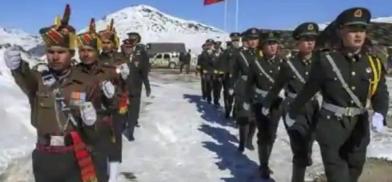India, China military-level talks over Ladakh standoff remain 'inconclusive'
Talks between India and China's military representatives on Tuesday to resolve the ongoing face-off in eastern Ladakh between the two countries remained inconclusive, government sources said

Talks between India and China's military representatives on Tuesday to resolve the ongoing face-off in eastern Ladakh between the two countries remained inconclusive, government sources said.
A Division Commander-level meeting was held between Major General rank officers of the two sides on Tuesday afternoon to resolve the issue but in the end it remained "inconclusive", sources said.
Before talks began, Northern Army Commander Lieutenant General Y.K. Joshi also reached Ladakh to review the ground situation.
Now, since no major success was achieved during the meeting, another round of talks between Indian and Chinese military leaders will be held on June 6. Indian Army Chief General M.M. Naravane is confident enough that the stand-off would be resolved at military level talks, sources said.
Earlier, Indian Army and China's People's Liberation Army held several meetings to resolve the face off , however no breakthrough has taken place.
In the meantime, China has sent a large number of troops to the Line of Actual Control as reinforcements. Seeing this, Indian Army has also deployed forces accordingly.
These four places where there is an eyeball-to-eyeball situation since May 5 at Line of Actual Control. Both sides have deployed over 1,000 troops eyeball-to-eyeball at all four places. Further reinforcements have also been made.
Indian Army is keeping close watch in the Pangong Tso (lake) sector of eastern Ladakh and the Galwan Valley region where the Chinese have enhanced deployment. Other than Pangong Tso that is extremely sensitive the other places that are volatile in wake of the recent escalation are Trig Heights, Demchok and Chumar in Ladakh which forms western sector of the India-China frontier.
The trigger for the face-off was China's stiff opposition to India laying a key road in the Finger area around the Pangong Tso (lake) besides construction of another road connecting the Darbuk-Shayok-Daulat Beg Oldie road in Galwan Valley.
India and China have expressed that the matter would be resolved through bilateral talks and both the countries are working upon it.
However, sources said, that the current standoff in Ladakh is not the usual patrolling face-off but part of the new combative strategy that was rolled out by China after Doklam.
In 2017, there was a 73-day stand-off between India and China at the India-China-Bhutan tri-junction at Doklam. China's road construction in Bhutanese territory was seen as an attempt to change the status quo by India and finally the road work had to be stopped by the Chinese.
Meanwhile, the US censured China for resorting to aggression along the Line of Actual Control (LAC) with India and not resolving the conflict as per the international law.
While expressing concern about the Chinese aggression against India in the Union Territory of Ladakh, Eliot Engel, Chairman of the US House Committee on Foreign Affairs, said on Monday that Beijing was demonstrating "once again that it's willing to bully its neighbours rather than resolve conflicts according to international law".
Hitting out at the Xi Jinping government, Engel said: "Countries must all abide by the same set of rules so that we don't live in a world where might makes right."
He strongly urged China to respect norms and use diplomacy and existing mechanisms to resolve its border questions with India.
The statement follows US President Donald Trump's offer of mediation in the ongoing face-off between Indian and Chinese troops along the LAC in Eastern Ladakh, which India has politely rejected.








Post a Comment